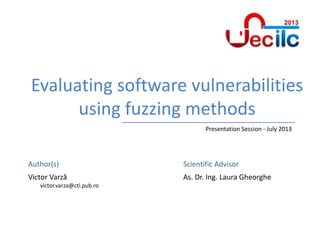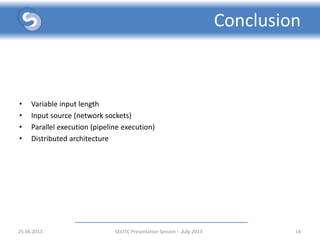Evaluating software vulnerabilities using fuzzing methods
- 1. Author(s) Politehnica University of Bucharest Automatic Control and Computers Faculty Computer Science Department Scientific Advisor Evaluating software vulnerabilities using fuzzing methods Victor Varză victor.varza@cti.pub.ro As. Dr. Ing. Laura Gheorghe Presentation Session - July 2013
- 2. Content • Introduction • Fuzzing • Blackbox vs Whitebox • Architecture of HybridFuzz • Implementation • Evaluation • Conclusion 225.06.2013 SECITC Presentation Session - July 2013
- 3. Introduction 3 • Software security bugs can be very expensive: – Cost of each Microsoft Security Bulletin: $Millions – Cost due to worms (Slammer, CodeRed, Blaster, etc.): $Billions • Most security exploits are initiated via files or packets – Ex: Internet Explorer parses dozens of file formats • Security vulnerabilities: – Buffer overflows – Segmentation faults – Memory corruption – NULL - pointer – division-by-zero 25.06.2013 SECITC Presentation Session - July 2013
- 4. Fuzzing • Automated testing of software applications • Identify security vulnerabilities • Automated test case generation • Blackbox, whitebox, graybox 4 Blackbox Fuzzing SpeedFast Slow CodeCoverageLowHigh Static Analysis Hybrid Fuzzing Concolic Execution Whitebox Fuzzing 25.06.2013 SECITC Presentation Session - July 2013
- 5. 5 Blackbox vs Whitebox Whitebox Blackbox Code exploration 25.06.2013 SECITC Presentation Session - July 2013 • Whitebox Is capable to discover all possible unique paths Is not scalable for large programs • Blackbox Generates a wide number of random test cases May explore deeper path of code program branch
- 6. Blackbox vs Whitebox (2) 6 • TRUST (Team for Research in Ubiquitous Secure Technology) • Catchconv (whitebox) - 279, 953 test cases; 304,936 errors (157 unique) • Zzuf (Blackbox) - 962,402 test cases; 1,066,000 errors (456 unique) • Mplayer, ImageMagick Convert, Adobe Flash Player and Antiword © M.Aslani 25.06.2013 SECITC Presentation Session - July 2013
- 7. HybridFuzz - Architecture 7 SISTEM UNDER TEST Path predicates collector KLEE Input data generator PPL Delivery mechanism Monitoring system Zzuf • KLEE - whitebox fuzzer developed by Stanford University, US • PPL – mathematical library developed by University of Parma, Italy • Zzuf – blackbox fuzzer developed by Caca Labs 25.06.2013 SECITC Presentation Session - July 2013
- 8. Path predicates collector 8 LLVM- GCC C/C++ application Bytecode KLEE KQuery files • C/C++ application source code • Compile using LLVM - GCC bytecode • Symbolic execution using KLEE query constraints 25.06.2013 SECITC Presentation Session - July 2013
- 9. Input data generator 9 Parser KQuery constraints Linear inequations PPL Input space • Query constraints Parser linear inequations • Numerical abstraction and convex polyhedra • Mixted integer linear programming problem • PPL + MIP input space 25.06.2013 SECITC Presentation Session - July 2013
- 10. Delivery and monitoring module 10 • Zzuf - blackbox mutation based fuzzer • Mutation ratio 0% • Segmentation fault, memory corruption 25.06.2013 SECITC Presentation Session - July 2013
- 11. Evaluation 11 1 int test(unsigned int t_a, int t_b) { 2 unsigned int a = t_a; // unsigned byte 3 int b = t_b; // signed byte 4 5 if (a >= 20) { 6 if (b <= -80) { 7 printf("PATH 1t"); 8 printf("a=%d, b=%dn", a, b); 9 return 1; 10 } 11 12 printf("PATH 2t"); 13 printf("a=%d, b=%dn", a, b); 14 return 2; 15 } 16 17 printf("PATH 3t"); 18 printf("a=%d, b=%dn", a, b); 19 return -1; 20 } 21 query [(Ult 19 (ReadLSB w32 0 a)) (Eq false (Sle (ReadLSB w32 0 b) 4294967216)) ] 19 < a b > -79 Symbolic execution with KLEE Query constraints to linear inequalities Create input space with PPL 25.06.2013 SECITC Presentation Session - July 2013
- 12. Evaluation (2) 12 Instrs Time(s) ICov(%) BCov(%) ICount 45 0.44 75.00 100.00 60 • Instrs - number of executed instructions • Time - total time • ICov - percentage of LLVM instructions that were covered • BCov - percentage of branches that were covered • ICount - total static instructions in the LLVM bitcode • x86 architecture: int = 4 bytes • Max number of tests case for PATH 2: 2147483627 x 2147483727 = 4611686142981437829 25.06.2013 SECITC Presentation Session - July 2013
- 13. Evaluation (3) 13 Coreutils code coverage App Instrs Time(s) ICov(%) BCov(%) ICount tr 974109 20.97 22.98 15.40 26697 ls 7581376 79.32 21.89 14.93 47197 seq 2080054 260.34 35.47 23.90 24445 mknod 566278 6.29 27.86 18.61 24137 25.06.2013 SECITC Presentation Session - July 2013
- 14. Conclusion 14 • Variable input length • Input source (network sockets) • Parallel execution (pipeline execution) • Distributed architecture 25.06.2013 SECITC Presentation Session - July 2013
- 15. 15 Thank you! SECITC Presentation Session - July 201325.06.2013











![Evaluation
11
1 int test(unsigned int t_a, int t_b) {
2 unsigned int a = t_a; // unsigned byte
3 int b = t_b; // signed byte
4
5 if (a >= 20) {
6 if (b <= -80) {
7 printf("PATH 1t");
8 printf("a=%d, b=%dn", a, b);
9 return 1;
10 }
11
12 printf("PATH 2t");
13 printf("a=%d, b=%dn", a, b);
14 return 2;
15 }
16
17 printf("PATH 3t");
18 printf("a=%d, b=%dn", a, b);
19 return -1;
20 }
21
query [(Ult 19 (ReadLSB w32 0 a))
(Eq false (Sle (ReadLSB w32 0 b) 4294967216))
]
19 < a
b > -79
Symbolic execution with KLEE
Query constraints to linear inequalities
Create input space with
PPL
25.06.2013 SECITC Presentation Session - July 2013](https://image.slidesharecdn.com/evaluatingsoftwarevulnerabilitiesusingfuzzingmethods-130923135658-phpapp02/85/Evaluating-software-vulnerabilities-using-fuzzing-methods-11-320.jpg)



